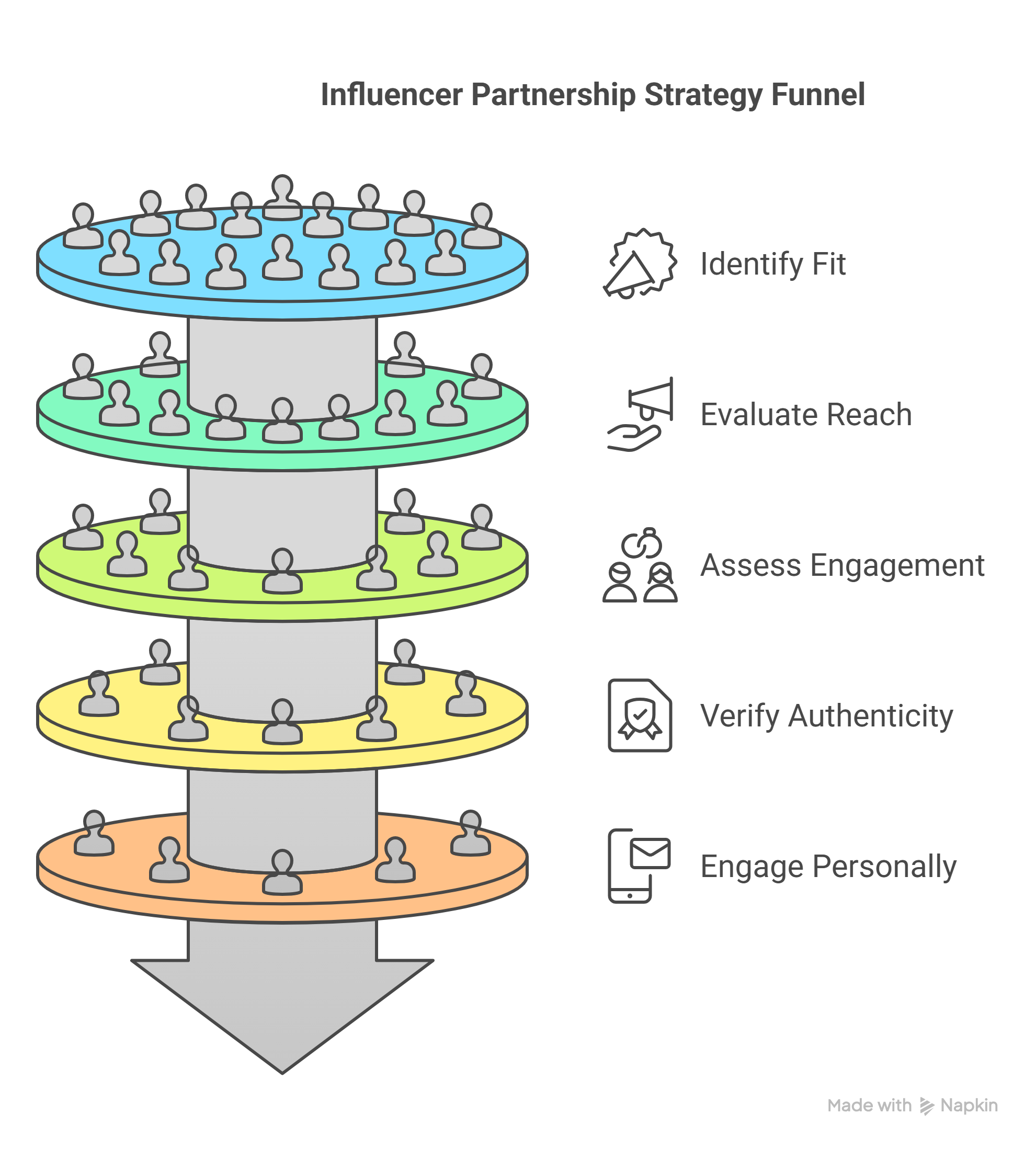Strategies for Identifying and Engaging Influencers
Finding the right influencers and building effective partnerships requires a strategic approach. Here's a breakdown of key steps:
Identification: Finding the Right Fit
Before reaching out, you need to identify influencers who align with your brand and goals. Consider these factors:
-
Audience Alignment:
- Concept: Does the influencer's audience demographic and interests match your ideal customer profile (your target 'persona')?
- Why it Matters: Reaching the right people is more important than just reaching many people. Marketing to an irrelevant audience is ineffective.
- Example: If you sell high-end, minimalist home decor, partnering with an influencer known for vibrant, eclectic DIY projects probably isn't a good fit, even if they have many followers. You'd look for someone whose audience appreciates minimalist design.
-
Relevance:
- Concept: Does the influencer's content niche naturally align with your product or service?
- Why it Matters: The collaboration should make sense and not feel forced. Relevant content ensures the influencer can speak authentically about your brand.
- Example: A skincare brand should partner with beauty or wellness influencers, not a tech reviewer, to maintain relevance.
-
Reach:
- Concept: How large is the influencer's following? Consider both macro-influencers (large followings) for broad awareness and micro-influencers (smaller, niche followings) for potentially higher engagement and trust.
- Why it Matters: Your goals determine the ideal reach. Broad awareness might need macro, while targeted conversions might benefit from micro.
- Example: A national fast-food chain might use a celebrity (macro) for a big launch, while a local artisan bakery might partner with a popular local food blogger (micro).
-
Resonance (Engagement Rate):
- Concept: How much interaction (likes, comments, shares, saves) does the influencer's content receive relative to their follower count?
- Why it Matters: High engagement indicates an active, interested audience, which is often more valuable than a large but passive following. Quality engagement trumps sheer follower quantity.
- Example: An influencer with 10,000 followers but hundreds of genuine comments per post (high resonance) might be more effective than one with 100,000 followers but only a few generic comments (low resonance).
-
Authenticity:
- Concept: Does the influencer seem genuine? Do their values align with your brand? Would a partnership feel natural or forced?
- Why it Matters: Audiences can spot inauthentic endorsements. A genuine connection leads to more trust and better results.
- Example: An influencer known for promoting sustainable living partnering with a fast-fashion brand might feel inauthentic and could damage both reputations.
Methods for Identification:
- Concept: Finding influencers involves active searching and research, similar to conducting market research.
- How: Use influencer marketing platforms/tools, search directly on social media platforms (e.g., Instagram, TikTok, YouTube), analyze your competitors' collaborations, and track relevant hashtags.
- Example: A vegan snack company might search Instagram for #veganrecipes, #plantbasedfoodie, or use a tool to filter influencers in the "vegan lifestyle" category with specific audience demographics.
Engagement: Building the Partnership
Once you've identified potential influencers, the next step is to reach out and build a relationship:
-
Personalized Outreach:
- Concept: Avoid sending generic, copy-pasted messages. Show that you are familiar with the influencer's specific content and style.
- Why it Matters: Personalization shows respect and increases the likelihood of getting a positive response. Influencers receive many requests; yours needs to stand out.
- Example: Instead of "Hi, wanna collab?", try "Hi [Influencer Name], I loved your recent video on [Specific Topic]! Your insights on [Specific Point] were great. We at [Your Brand] have a new [Product] that aligns with your focus on [Their Niche], and we'd love to explore a potential partnership..."
-
Clear Value Proposition:
- Concept: Clearly communicate what the influencer gains from the collaboration.
- Why it Matters: Influencers invest time and effort. You need to offer fair value, whether it's monetary compensation, free products, exclusive experiences, commission, or cross-promotional opportunities.
- Example: "We propose a partnership including [X amount] payment and a free supply of [Product] for a dedicated Instagram post and 3 stories featuring the product authentically within your content style."
-
Relationship Building:
- Concept: Aim to build long-term partnerships rather than just single, transactional campaigns.
- Why it Matters: Ongoing relationships foster deeper authenticity and brand advocacy. It's often more effective and cost-efficient than constantly finding new influencers. This mirrors the concept of building customer loyalty.
- Example: Engage with the influencer's content regularly (even when not collaborating), offer them early access to new products, or invite them to brand events to nurture the connection beyond paid posts.
-
Clear Communication & Expectations:
- Concept: Maintain professionalism throughout the process. Provide clear campaign briefs, outline deliverables, specify timelines, and discuss content approval processes.
- Why it Matters: Clarity prevents misunderstandings and ensures both parties are aligned on goals and expectations, leading to smoother collaboration.
- Example: Providing a detailed brief including key message points, required hashtags, disclosure guidelines (#ad), posting dates, and reporting requirements.


No Comments